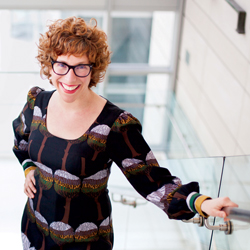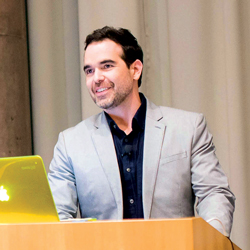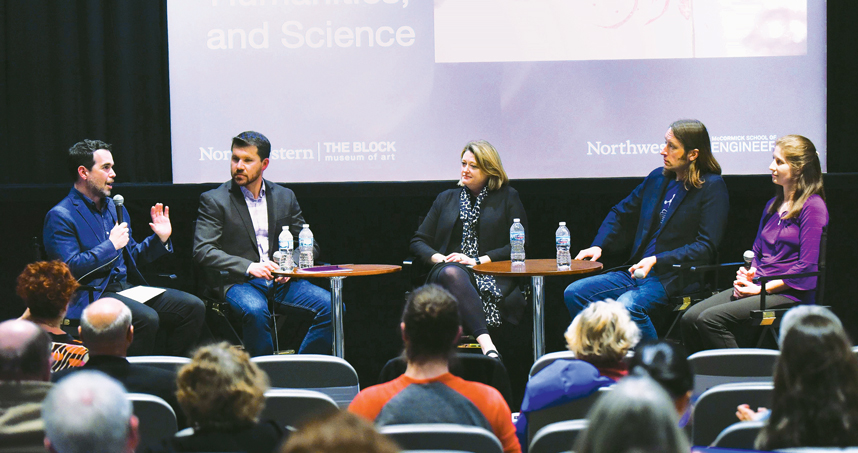Connecting Art + Engineering
Artist-at-Large Dario Robleto makes the case for multidisciplinary collaboration to address critical social and ethical issues.
Sparking Vital Conversations
 PREFACE BY SUSY BIELAK
PREFACE BY SUSY BIELAK
Three years ago, leaders at Northwestern Engineering and the Mary and Leigh Block Museum of Art had an idea— to directly engage artists with engineers by embedding an Artist-at-Large with the McCormick School of Engineering. The goal was broad— to spark vital conversations between members of two highly creative, cutting-edge fields and then wait to see what happened.
As curator of the program, I worked with Dean Julio M. Ottino and Lisa Corrin, director of the Block, to bring five contemporary artists to campus over the course of a year to discover intersections between their work and what’s happening at Northwestern Engineering. The artists lectured on their work and met with faculty in areas ranging from robotics, computer science, and nanotechnology to political science, sociology, poetry, and art history.
Among those notable artists, we found Dario Robleto uniquely positioned to serve as the first artist for this initiative. A transdisciplinary artist, researcher, and writer based in Houston, his exploration of music, popular culture, science, war, and history has often resulted in intricately handcrafted objects.
Focused on the creative response to loss, he draws on wide-ranging, unconventional materials from meteorites to lost recordings of heartbeats from the 19th century. What underpins all of Robleto’s projects is his humanism—a bridge connecting necessary and important conversations that, until his arrival, had gone unspoken.
Early on, we connected Robleto with Megan Crowley-Matoka, associate professor of medical education and anthropology at Northwestern University Feinberg School of Medicine, and with Julius Lucks, associate chair and associate professor of chemical and biological engineering. Soon, we realized that Robleto needed to connect with Lucks’s colleagues at the Center for Synthetic Biology—where ethics and societal impact form one of the program’s four pillars.
Since then, their conversations have ranged from the limits of life at a cellular level to how ideas around altruism and generosity have real-life repercussions for our health. Naturally, big questions have emerged:
-
How do ethical considerations impact decisions that scientists and researchers make every day?
-
How can engineers, as socially conscious humans, adapt science to social needs?
-
And, importantly, what is our responsibility to take a stake in technologies that redefine fundamental aspects of life itself?
These conversations, initiated by Robleto’s curiosity and humanism, have the power to alter the course of Northwestern engineers’ research—and to shape the future. Thank you, Dario, for embarking on this journey with us, sharing your insight, capaciousness, and boundless curiosity.
Susy Bielak served as the Susan and Stephen Wilson Associate Director of Engagement and Curator of Public Practice at the Mary and Leigh Block Museum of Art and curated the inaugural Artist-at-Large Program at Northwestern Engineering.
Exploring Ethics Across Fields
 In the Spring of 2018, I was appointed Artist-at-Large in an ambitious cross-disciplinary initiative between Northwestern Engineering and the Mary and Leigh Block Museum of Art. Under the visionary leadership of Dean Julio M. Ottino and Lisa Corrin, director of the museum, I have been afforded incredible access to various brain trusts in one of the country’s premier universities.
In the Spring of 2018, I was appointed Artist-at-Large in an ambitious cross-disciplinary initiative between Northwestern Engineering and the Mary and Leigh Block Museum of Art. Under the visionary leadership of Dean Julio M. Ottino and Lisa Corrin, director of the museum, I have been afforded incredible access to various brain trusts in one of the country’s premier universities.
The question at the heart of this initiative could not be more timely and relevant: What constitutes meaningful collaboration among people from different disciplines and disparate fields?
A New Paradigm with Far-reaching Impact
On this vital point, the challenges between the arts and humanities on one end and the sciences and engineering on the other are significant. There is a perception that we do not have much in common in how we formulate questions and methodological approaches; how we navigate the differences between the objective and subjective; how we determine “results;” and what the broader impacts
of such transdisciplinary collaboration would entail.
In the context of limited time and resources, for an outcomes-oriented engineering school of Northwestern’s caliber to give a contemporary artist a “hall pass” to wander through departments and classes based purely on curiosity and undefined possibilities could not be riskier. Creating the infrastructure for such work to occur is to value process as much as the product and intellectual patience across disciplines more than suspicion and competition.
These are not trivial details. Artists like me, who advocate for this disciplinary patience and integration, mostly operate independently with little sustained support. What the dean and director are building together is not only a commitment to intellectual diversity among students and faculty, but also a program with, potentially, broader societal impact.
The disciplinary distinctions between the arts and sciences of today were not always necessary. For complex historical reasons, the arts, humanities, engineering, and sciences split in such ways that we often forget what we have in common. This, I feel, has come with a significant loss to society as a whole. Specialization within academic fields has accelerated to such an extent that, at least on paper, it seems hard to argue what meaningful dialogue an artist could have with a theoretical physicist, a heart surgeon, or an astrobiologist. Equally, it is quite a stretch to imagine how a biologist may challenge a sculptor or a performance artist.
Increasingly, though, the complexity of our inquiries into nature through one domain are so expansive that they transcend their field of origin and require multiple disciplines to address them adequately. After several months of research in various departments at Northwestern, it became clear to me that one field in particular demanded the effort of such multidisciplinary attention: synthetic biology.
Scientific Advancement Raises New Moral Questions

Synthetic biology’s radical advancement—human control and design of the human genome—is not only a technical feat, but also falls into that rare classification of scientific advancements that are existential, extending far beyond the laboratory. Like all forms of power, especially one that harnesses the mechanisms of biological life, synthetic biology is now susceptible to the full range of competing human needs and desires: access and control, self-interest and the greater good, well-being and abuse.
As synthetic biology’s potential unfolds—curing all genetic diseases to its inevitable weaponization—its impact will stretch across cultural and social dynamics, religious thought, philosophical inquiry, global economics, artistic representation, and ethical norms. But it is this last consideration—ethics—that makes an urgent case for the reintegration of the arts, humanities, and sciences. For it is through ethics, and the social engagement it requires, that complex, laboratory-based science, such as synthetic biology, can embrace its connection to the humanity and public responsibility underlying the work.
As an artist, but also as a citizen with a deep appreciation for science, something that deeply concerns me is the growing public divide and mistrust about scientific investigation and its perceived, but perhaps very real, lack of ethical and moral oversight. Increasingly, many scientific and medical fields are not just operating within existing, well-trodden ethical terrain—the Hippocratic oath or patient consent, for example—they also are inventing new ethical questions no one ever thought to ask. (Perhaps most provocatively, should we take the reins of evolution into our own hands?) When all the public sees are headlines about science moving forward because it can, before ever asking if it should, it damages the kind of public dialogue we need to be having about issues that will affect us all.
But what does it mean to create work that outpaces ethical deliberation and public understanding? Are there sufficient pathways for scientists to consult with ethicists, moral philosophers, and artists or even to consider perspectives entirely outside academia, like economically or racially marginalized groups, people with disabilities, patients and their families, or religious groups?
What does it mean if, partly through the breakdown between the arts, humanities, and sciences, a generation of scientists is unequipped to think through the social and ethical consequences of their work? Essentially, how do we draw on the full range of humanity’s creative and moral imagination when dealing with groundbreaking scientific developments?
As an artist, I feel I have a responsibility to remain informed and to utilize the incredible power of the arts as a type of poetic checks and balances to the sciences, poking and prodding with questions different from those my scientific counterparts may ask. Further, the arts are uniquely designed to aid with the translational work to the public through building the metaphors, symbols, allegories, public programs, or whatever form is necessary to communicate clearly.
Interdisciplinary Reflection and Introspection
It is within this confluence of cutting-edge science, ethics, social responsibility, and the critical and translational power of the arts that, with the generous participation of colleagues from the synthetic biology and bioethics departments, I was able to moderate a public event addressing many of the concerns I have laid out.
As I learned from observing and listening in on numerous conversations, my colleagues—synthetic biologists Josh Leonard, Danielle Tullman-Ercek, and Julius Lucks; and medical anthropologist Megan Crowley-Matoka—are driven not only by their individual research goals, but by the fact that they are socially conscious humans who care about the broader consequences of their work.
To honor the on-the-ground complexity of these scientists’ experiences, it was crucial not to focus just on the worst-case scenarios of science run amok. Instead, I wanted to highlight the many inventive and nimble ways these scientists do rise to the ethical responsibilities their fields require, even while they reflect that the systems of ethical dialogue and oversight are far from adequate moving forward.
The format was designed for each of us to share an experience within our fields where an ethical conundrum unexpectedly appeared. At that moment, we had a choice: ignore it, work around it, let others worry about it, or challenge ourselves to embrace the problem and perhaps even let it determine how we move forward.
Not only did we lay out clear examples of ethical conundrums within our fields (“dual-use” technology, the limitations of existing patent structures for the common good, the problems of self-regulation, the ethical responsibility of art-science collaborations, etc.), we also designed the evening to put our disciplines’ modes of inquiry and problem-solving in comparison, alignment, or misalignment, revealing aspects that surprised us in our commonalities or challenged us in our differences.
Collaboration for the Common Good
As I have observed over many years, the vast majority of the public never interacts directly with scientists or artists. Equally rare is for scientists and artists to publicly or privately speak face to face. Our processes and motivations remain obscured, often filtered through various popular culture media that usually operate within clichés.
But, in an era where scientific advancements will increasingly complicate a wide range of cultural and social issues, it is irresponsible for the arts, humanities, and sciences to remain in their status quo—comfortable in disciplinary silos. Further, in the current climate of distrust and polarization of thought, with growing public skepticism of the sciences and arts in particular, having a public and civil discussion amongst ourselves about ethics is itself a statement about our responsibility to work together for the greater social good. It is through initiatives such as Northwestern’s Artist-at-Large Program that we can build a new model for how this work is accomplished. I want to thank Julio and Lisa for their visionary leadership and long-term commitment to intellectual diversity and dialogue between the arts and sciences; Susy Bielak, former curator of public practice and associate director of engagement at the Block Museum of Art; and Kyle Delaney, executive director of strategic initiatives and marketing at the McCormick School of Engineering, for their expert guidance, management, and patience as we discovered the possibilities of this program together.
